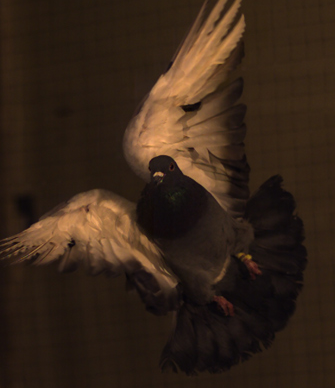Science News
Helicopter Pigeons
November 30, 2011

If pigeons are rats with wings, then aloft, they are certainly agile and efficient rats with wings. Or so reports a new study in the Proceedings of the National Academy of Sciences.
Researchers at the Concord Field Station of Harvard University used synchronized high-speed cameras to track pigeons performing low-speed, level, 90-degree turns through a square-corner corridor inside of a parking lot. You can see some of the video at New Scientist. Surprisingly graceful, yes?
That wasn’t the only surprise. The researchers found that the birds navigate as a helicopter would. Pigeons produce the aerodynamic forces necessary to counteract gravity and propel themselves forward by pushing against surrounding air with their bodies, wings and tails. The birds produce aerodynamic forces in a uniform direction relative to their bodies.
ScienceShot reports:
Unlike a rocket that simply swivels its jets, a pigeon doesn't turn by redirecting the forces it generates relative to its body. Instead, the bird realigns those forces by rotating its entire body, primarily by tipping its wings into the turn. A helicopter uses the same tipping strategy, lowering its nose to accelerate forward, for example.
The authors also found that the pigeon's upstroke generates aerodynamic lift that is about half of that generated during the downstroke, a relatively high contribution that nearly matches the upstroke of hummingbirds.
New Scientist describes broader implications for this research.
The humble pigeon could provide the unlikely inspiration for a flock of small military drones that can navigate enclosed spaces.
Image: Ivo Ros